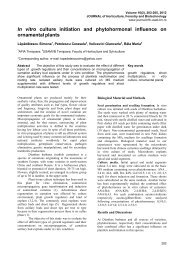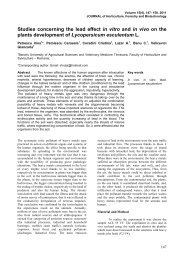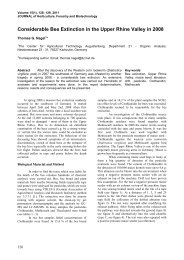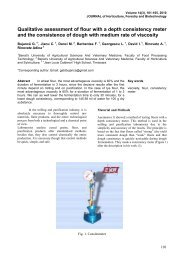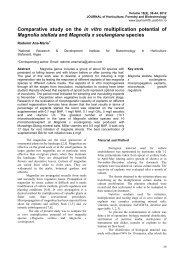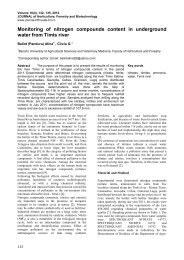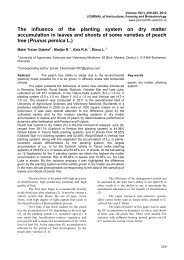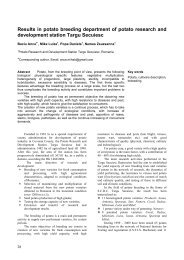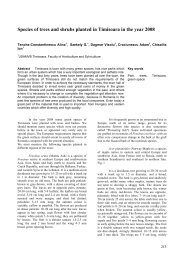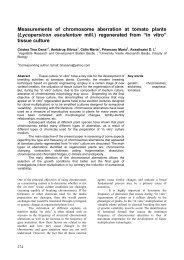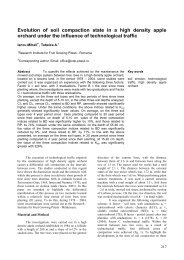Predators of Pityogenes chalcographus (Coleoptera:Scolytidae) <strong>in</strong> Natural Park ApuseniFora, C.G. 1* , Lauer, K.F. 2 , Berar, C. 1 , Ştefan, C. 1 , Silivăşan, M. 1 , Lalescu, D. 11 Banat University of Agricultural Sciences <strong>and</strong> Veter<strong>in</strong>ary Medic<strong>in</strong>e <strong>from</strong> Timisoara; 2 University of AppliedSciences Weihenstephan-Triesdorf* Correspond<strong>in</strong>g author. Email: foraciprian@yahoo.comAbstract Alongside the European spruce bark beetle, <strong>in</strong> the Natural ParkApuseni, the small spruce bark beetle Pityogenes chalcographus encounteredfavourable mass reproduction conditions. Thus, massive attacks at the trees‟feet were observed <strong>in</strong> different arboreta. This phenomenon will largely spreadunless urgent measures for eradicat<strong>in</strong>g the pest hole are undertaken. This iswhy we have decided to <strong>in</strong>vestigate the parasitoid populations for Pityogeneschalcographus <strong>in</strong> the protected environment. In 2011 the most numerousspecies were: Nemosoma elongatum, Rhizophagus cribratus, Rhizophagusdepressus, Thanasimus formicarius, Quedius plagiatus, Quedius lateralis,Quedius cruentus, Quedius xanthopus.Key wordsPityogenes chalcographus,predators, Natural ParkApuseniParasitoids of Ips typographus (Coleoptera: Scolytidae) <strong>in</strong> theNatural Park ApuseniFora, C.G. 1* , Lauer, K.F. 2 , Banu, C. 1 , Berar, C. 11 Banat University of Agricultural Sciences <strong>and</strong> Veter<strong>in</strong>ary Medic<strong>in</strong>e <strong>from</strong> Timisoara; 2 University of AppliedSciences Weihenstephan-Triesdorf* Correspond<strong>in</strong>g author. Email: foraciprian@yahoo.comAbstract Dur<strong>in</strong>g the last years, <strong>in</strong> the Natural Park Apuseni, the Europeanspruce bark beetle encountered favourable mass reproduction conditions.Thus, massive attacks at the trees‟ feet were observed <strong>in</strong> different arboreta.This phenomenon will largely spread unless urgent measures for eradicat<strong>in</strong>gthe pest hole are undertaken. This is why we have decided to <strong>in</strong>vestigate theparasitoid populations <strong>in</strong> the protected environment. In 2011 the mostnumerous species were: Coeloides bostrichorum, Roptrocerus xylophagorum,Rhopalicus tutela, Dendrosoter middendorffi <strong>and</strong> D<strong>in</strong>otiscus eupterus. Amongthese, the first two parasitoid species are also the best represented <strong>in</strong> number(>70%).Key wordsIpstypographus,parasitoids, Natural ParkApuseni
Manifestation of the productive potential of early cabbagehybrids grown <strong>in</strong> unheated greenhouses under the <strong>in</strong>fluence ofstart <strong>and</strong> phase root fertigation with modern fully solublechemical fertilizersBecherescu Alex<strong>and</strong>ra 1* , Horgoş A. 1 , , Popa D. 1 , Ienciu Anişoara 1 , Drăgunescu Anca 1 ,Stepan I. 21 Banat‟s University of Agricultural Sciences <strong>and</strong> Veter<strong>in</strong>ary Medic<strong>in</strong>e Timişoara; 2 Family Association*Correspond<strong>in</strong>g author. Email: alex<strong>and</strong>ra_becherescu@yahoo.comAbstract Early cabbage, a vegetable species that cont<strong>in</strong>ues production ofother species as early green onions, radishes, sp<strong>in</strong>ach, squash, holds asignificant share <strong>in</strong> the range of size of field vegetables <strong>and</strong> greenhouses,large market requirements, <strong>and</strong> substantial profit it br<strong>in</strong>gs. There werecultivated varieties <strong>and</strong> hybrids valuable years ago, but the new varietiesappeared, be<strong>in</strong>g evidently replaced <strong>in</strong> culture.In this paper we present the behavior of new hybrids grown amidtechnological improvement of l<strong>in</strong>ks lead<strong>in</strong>g to obta<strong>in</strong> high yields <strong>and</strong> quality todeal with market competition..Key wordsspecies,assortment,technologyproduction,grower,Increas<strong>in</strong>g productive efficiency of a culture of mushroomAgaricus bisporus as a result of improvement of technologicall<strong>in</strong>ks for nutrient substrate cultivation <strong>and</strong> plant protectionHorgoş A. 1* , Becherescu Alex<strong>and</strong>ra 1 , Popa D. 1 , Drăgunescu Anca 1 , Ienciu Anişoara 1 , NeagT. 21 Banat‟s University of Agricultural Sciences <strong>and</strong> Veter<strong>in</strong>ary Medic<strong>in</strong>e Timişoara; 2 Family Association*Correspond<strong>in</strong>g author. Email: horgos_a@yahoo.comAbstract Cultivation of Agaricus bisporus mushrooms (Champignonmushrooms), <strong>in</strong> areas that orig<strong>in</strong>ally had another purpose (warehouses,stables, workshops to raise chickens or hens, etc.), requires compliance <strong>and</strong>enforcement largely of the same technologies of culture. But someadjustments are needed <strong>in</strong> the way of settlement of the crop nutrient substrateproduction build<strong>in</strong>g, currently us<strong>in</strong>g two methods of settlement on the shelves:the recipients of PE foil bags placed vertically <strong>and</strong> PE foil conta<strong>in</strong>ers ofrectangular shape placed horizontally.Initiated research aimed at determ<strong>in</strong><strong>in</strong>g the best type of conta<strong>in</strong>er foruse <strong>in</strong> culture, <strong>in</strong> terms of coverage us<strong>in</strong>g a mixture prepared by differentrecipes <strong>and</strong> substrate combat nematodes <strong>and</strong> <strong>in</strong>sects fly<strong>in</strong>g <strong>in</strong> the local air,with various products (Nemasys M, Dimil<strong>in</strong>). Establish<strong>in</strong>g conclusions <strong>and</strong>recommendations was based on quantify<strong>in</strong>g productive efficiency for aproduction cycle <strong>and</strong> then for one year.Key wordsspace, local culture,production, technology,conta<strong>in</strong>er, nutritivesubstrate, nematodes,<strong>in</strong>sects



